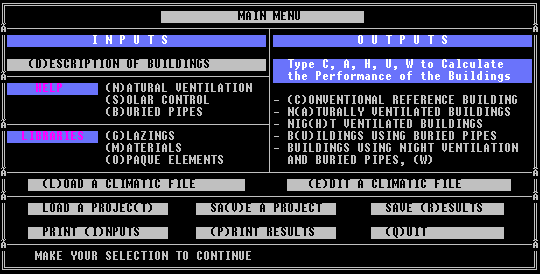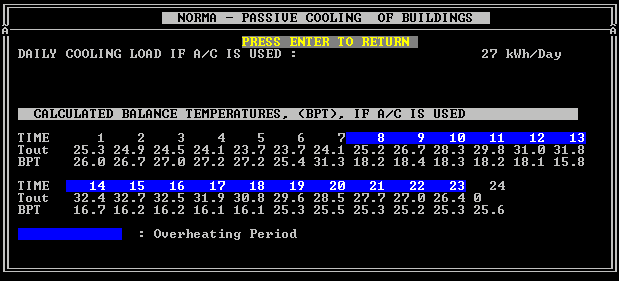THE COMPUTER
NORMA is a DOS based piece of software. It is a relatively simple package and will run on practically any 286 or higher computer, with VGA screen, floppy drive and hard disk. The screen can be colour or black and white. There is no need for a maths co-processor.
THE PRINTER
Any printer supported by your computer will be sufficient. Outputs are not very elaborate graphically, so a dot matrix printer is more than adequate.
NORMA is supplied on a single Double Density 3 1/2 inch floppy disk. The files are all compressed but expand on installation. They contain all the necessary files and libraries required in order to run NORMA. Having installed the programme, the user is introduced to the main menu as shown below:

NORMA Main Menu
NORMA as follows:
The first three items relate to the components of construction and secondary calculations, while the forth describes the proposed building in terms of shape, size, and orientation.
There are three libraries supplied with NORMA - Glazing, Materials and Opaque Elements. The first stage is to ensure that these libraries contain all the relevant information for the scheme. If they do not, entries can be simply added.
NORMA already contains 100 entries, 67 with actual data and the remainder blank.
These materials are used to construct elements in the Opaque Elements Library.
This library deals with multi-layer constructions or elements like walls, roofs and floors. The library provides for up to 60 elements maximum, with up to six layers per element.
NORMA contains climatic files for many of the principal locations in Southern Europe for the representative day, the 21st July. It is necessary for the designer to ensure that the information for the location being considered is available, and if not, to make a new climate data file for that location. climatic data files consist of hourly Solar Radiation in W/m2 and Ambient Temperature in degrees C. The Solar Radiation value is the radiation intensity as incident on a horizontal surface. The latitude of the location must also be provided.
NORMA considers three techniques for cooling as follows:
When NORMA considers natural ventilation it needs to know the number of air changes per hour (ACH/hr). The Natural Ventilation routine will then calculate the air change rate.
The information required is a follows:
For each external window, the following is required:
The last parameter, the Pressure Coefficient, determines the effect the wind will have on an opening, and depends on the angle of incidence of the wind on the opening.
Controlling the amount of solar radiation entering through openings is an important part of keeping buildings cool inside. Solar radiation can penetrate openings directly, or can be reflected by objects around the building or by the ground below the window. The Solar Control Tool calculates the following:
It considers windows with no shading device, recessed windows, windows with side fins and windows with overhangs (see figure 2). Results are given for a particular month or a number of months specified by the user.
Solar Control requires the following information:
Start - End Month (1 -12)
Site latitude (30 to 66 deg)
Window Azimuth (-180 to 180 deg) See diagram
Window tilt (80 - 90 deg)

Types of Shading Device (0 - 3)
0 - None
1 - Recessed window
2 - Side Fins
3 - Overhang

This routine is only relevant if such cooling devices are being considered in the design. It calculates exit air temperature from buried pipes.
This routine requires the number of external opaque components, i.e., walls, roofs
and possibly floors. This number is equal to the number of external walls plus the external
roof. If the roof is made up of more than one element i.e., a two slope roof, then it
counts for two elements. Only floors not in direct contact with the ground should be
included.
After entering the number of elements, enter the following five values:
Enter the number of glazed surfaces in the building envelope. Then edit the value for
each glazed element. The values required are as follows:
This routine identifies the number of internal partitions, their area in
m2 and make-up in terms of opaque element(s).
This option requires only one set of data for the building as follows:
As with the Floor and Operational Data above this option requires only one set of data
for the building as follows:
This value in ACH/hr is only necessary where a building is to be naturally
ventilated. The value should be taken from the Natural Ventilation Tool results described
earlier, or from another source if the Natural Ventilation Tool was not used, i.e.,
the CIBSE Guide.
The only data required for this option is the number of ACH/hr, but it must be
a value for the night period rather than the daytime. This value is calculated from the
Natural Ventilation routine, but using climatic data for the night time.
Five calculations are possible with NORMA as follows:
An Example of the output from calculation 1 is shown below. Each one calculates the
energy
required both for air-conditioning on its own, and for supplementing the natural cooling
technique. It displays the Balance Point Temperature and the External Ambient Temperature
for each hourly period of the day. It also highlights the hours of the day when the
External Ambient Temperature exceeds the Balance Point Temperature. It is during these
hours that energy will have to be provided to supplement the natural cooling. A percentage
energy saving relative to complete air-conditioning is also given for calculations 2-5,
which are similar to the Reference Building results shown below.
From the results the user can see how the building performs. It may then be necessary
reconsider some of the design aspects such as opening sizes and orientation, and to re-run
NORMA.
NORMA Example Calculation Results, Conventional Reference Building using
A/CNORMA - BUILDING DESCRIPTION
 There are seven items on the Buildings Characteristics Menu as follows:
There are seven items on the Buildings Characteristics Menu as follows:
EDIT EXTERNAL OPAQUE ELEMENTS
EDIT GLAZED SURFACES
INTERNAL PARTITIONS
4.4 FLOOR AND OPERATIONAL DATA
 The last item is a value between 1 and 4, with the options shown in a table on the top
right of the screen. If occupancy patterns suggested do not match the requirements, choose
the closest match.
The last item is a value between 1 and 4, with the options shown in a table on the top
right of the screen. If occupancy patterns suggested do not match the requirements, choose
the closest match.
INTERNAL GAINS
NATURAL VENTILATION
NIGHT VENTILATION
CALCULATIONS
